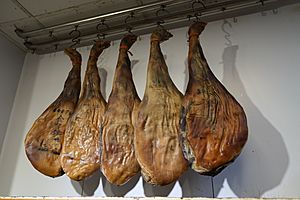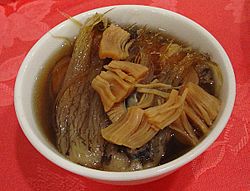Jinhua ham facts for kids

Jinhua ham
|
|
| Alternative names |
|
|---|---|
| Type | dry-cured ham |
| Place of origin | China |
| Region or state | Jinhua |
| Jinhua ham | |||||||||
|---|---|---|---|---|---|---|---|---|---|
| Traditional Chinese | 金華火腿 | ||||||||
| Simplified Chinese | 金华火腿 | ||||||||
|
|||||||||
Jinhua ham is a special type of dry-cured ham. It gets its name from the city of Jinhua in eastern China, where it is made. People in China use this ham to add amazing flavor to many dishes. It's great in stews and braised foods. It also makes delicious broths and Chinese soups. This famous ham even won a top award at the 1915 Panama International Merchandise Exhibition!
How Jinhua Ham is Made
Jinhua ham is traditionally made from the back legs of a special pig breed. These pigs are called "two ends black" (兩頭烏). They have black hair on their heads and rear ends, with a white middle section. These pigs grow quickly and have excellent meat quality with thin skin.
Making Jinhua ham starts when the air gets cool, usually below 10 degrees Celsius (50 degrees Fahrenheit). The whole process takes about 8 to 10 months to finish.
The Six Steps to Making Ham
Making Jinhua ham involves six main steps. They begin in winter and finish the next autumn:
- Getting the Meat Ready: First, workers choose strong, healthy pig legs. They carefully trim off extra fat, tendons, and other bits from the "open" side of the leg. Any leftover blood is also squeezed out.
- Salting the Ham: Salting happens when the temperature is between 5 and 10 degrees Celsius (41-50 F). This temperature helps the salt soak in well and stops bad germs from growing. Workers rub salt onto the meat many times over several days. They use a special method to make sure all important parts of the ham get salted. This salting process is repeated 5 to 7 times and takes about one month. Usually, only plain salt is used. Some makers might add a little sodium nitrate too.
- Washing and Soaking: After the ham is well salted and partly dry, it is soaked in water for 4 to 6 hours. Then, it is scrubbed clean. After this first wash, the hams soak again for another 16 to 18 hours.
- Drying and Shaping: Next, the hams are shaped to look like a bamboo leaf. Their hooves are removed, and they are marked with a hot iron. Then, they are hung in the sun to dry. Sun-drying stops when the ham starts to drip melted fat. This usually takes about a week.
- Ripening the Ham: The dried hams are then hung in a cool room, about 15 degrees Celsius (59 F), with 55-57% humidity. Here, they dry, cure, and develop their special smells over 6 to 8 months. During this time, good mould grows on the hams. Also, natural processes break down proteins and fats. This makes the ham taste much better by creating new flavor compounds.
- Final Ripening: After ripening, the ham is cleaned to remove any mould or dust. A thin layer of vegetable oil is put on the ham. This makes it softer and stops the fat from spoiling too much. The dried hams are then stacked on top of each other. They ripen for another 2 to 3 months. This helps the flavors become stable and even stronger.
New ways of making Jinhua ham can speed up the process. By changing the aging temperature and humidity, the ham can be ready in just 1 to 2 months.
Jinhua Ham in Culture

People first wrote about how to make Jinhua ham during the Tang Dynasty (618–907 AD). Some stories say that Marco Polo brought this dry ham making method to Europe. The name Jinhua was given to the ham by the first emperor of the southern Song Dynasty.
Jinhua ham is highly valued in Chinese cooking. You can eat it as part of a cold meat dish. It is also used to make soup stock. It gives a special, savory, and rich umami flavor to any dish. Jinhua ham is a very important part of the famous dish called Buddha Jumps Over the Wall.
This ham has even been praised in Chinese literature. It was a big part of the Qing dynasty novel Dream of the Red Chamber. In the book, it described the fancy food eaten by noble families.
An ideal Jinhua ham should look and taste a certain way. It should have a shiny, smooth yellow outside. Its shape should be round, like a bamboo leaf. It should have a small joint and hoof, and a thin, slender bone. Inside, there should be a good layer of fat around dark red meat. It should have a strong but pleasant smell. The meat should be fine-textured with lots of fat mixed in. The taste should be very salty, savory (umami), and sweet. It's normal for the outside of the ham to have a little mould. This mould is actually thought to help with the ham's flavor!
See also
 In Spanish: Jamón de Jinhua para niños
In Spanish: Jamón de Jinhua para niños

